Sediment and Silt Traps
What
Sediment can flow into waterways and lakes impacting freshwater ecosystems and aquatic life. Silt-traps are treatment systems designed to capture suspended sediment in drains carrying agricultural runoff thereby reducing sediment accumulation in downstream lake ecosystems. Once the water velocity reduces to a certain level then the fine sediment in the water column drops out to the bottom of the sediment trap. Silt-trap wetlands are treatment systems designed to capture suspended sediment and nutrients including nitrogen and phosphorus. Wetland plants and aquatic communities use the nutrients in the water for growth therefore reducing the amount of nutrients flowing downstream into the lake.As well as sediment pools there are several other low tech sediment trap techniques that could easily be implemented by farmers. These include hay bale sediment traps and sediment sumps at the terminals of trenches.

Image Source: Rebecca Eivers
Why
Silt (sediment) provides a significant source of phosphorus. It also decreases the depth of waterbodies and clouds water affecting both aquatic plant and animal life. Research in NZ has shown sediment traps to be very effective in capturing silt with a capture rate of 70% reported in one large Canterbury trial. Monitoring of traps has shown they capture faecal bacteria as well as phosphorus which binds to fine sediment. Sediment traps are also beneficial for fish as they provide pools of slower moving water where the fish can rest, an important part of fish survival. Silt-traps can benefit both the aquatic environment and the landowner, as sediment captured in silt-traps can be returned to the land when the silt-traps are cleaned out. This returns both nutrients and soil back to where it belongs.
Examples from research projects around NZ
Kaikoura Plains Recovery Project
Aqualinc is assisting the Kaikōura Plains Recovery Project (KPRP) with drainage solutions on a number of farms around Kaikōura. The 2016 Kaikoura earthquake caused extensive land damage and many pastoral areas became waterlogged and unproductive as a result.
Initial assessments of farms for proposed drainage strategies need to assess any contamination which might occur via sediment loss to adjacent creeks and waterways during excavation. Aqualinc developed several low-tech sedimentation control techniques that could easily be implemented by farmers. These included hay bale sediment traps and sediment sumps at the terminals of trenches.
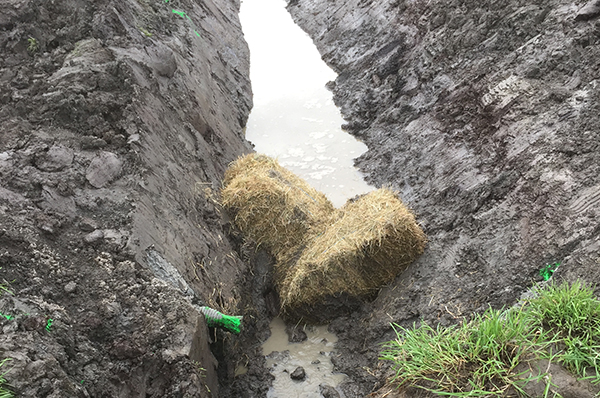
Photo Source: Aqualinc
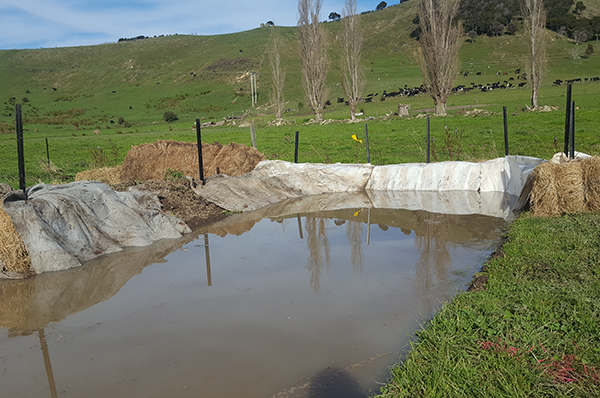
Photo Source: Aqualinc
Carex Project
Canterbury Water Rehabilitation Experiment (Carex) is a project undertaken by the University of Canterbury\‘s Freshwater Ecology Research Group.
In partnership with Living Water, we investigated the water quality issues of the Ararira/LII catchment near Lincoln, and advised on potential rehabilitation tools. We identified localised cases of elevated nitrate, phosphate and E.coli. However, excessive sediment was a widespread issue in this catchment, and we believe that this impacts both the ecological communities as well as the drainage functioning of the network.
Firstly, to understand how and when sediment moves through the system, they used a combination of stage height loggers to continuously record water levels, and sampled sediment during floods and sediment transported along the bed of the waterway. Most of the sediment was silt and fine sand (< 0.25 mm), which means that these particles will take a long time to fall out of suspension and be deposited on the streambed.

To reduce sediment being transported out of the system and into Te Waihora/Lake Ellesmere the researches have been installing sediment traps. A sediment trap provides a simple, effective, and potentially money-saving way to deal with excessive sedimentation in affected waterways.
The trap is constructed by basically digging a hole in the streambed to create a pool. The water velocity drops as it moves into the pool and if the water velocity is reduced down to a certain level, then the fine sediment in the water column drops out to the bottom of the sediment trap. In a large sediment trap trial in a stream near Rangiora researchers found that 70 % of sediment in the water was captured. Monitoring of the traps by the Crown Research Institute ESR revealed they also capture faecal bacteria.
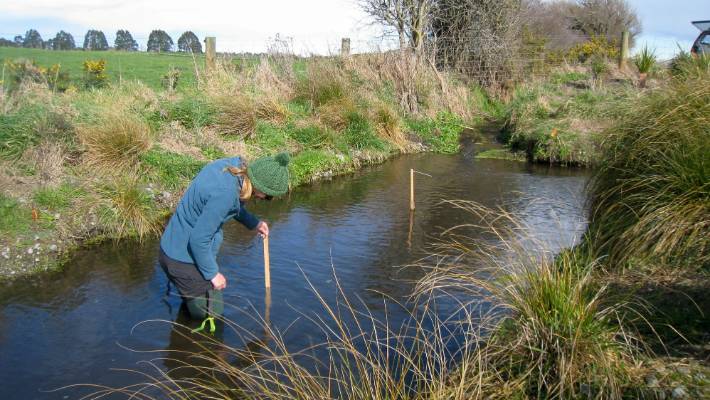
To enable more sediment traps to be constructed, the researchers created a simple table using easily-obtained measurements (water velocity and waterway width) to guide the design. This table provides a guideline for anyone to build a sediment trap to capture approximately 50-60% of the transported load. This design focused on fitting within the current waterway dimensions, to limit the effect on the surrounding land and facilitating the use of sediment traps in space-limited catchments.
| Suggested Trap Length × Depth | Average width (m) | |||
|---|---|---|---|---|
| <1.5 | 1.5-3.0 | 3.0-4.5 | ||
| Water velocity (ms-1) | <0.2 | 4.0 × 0.5 | 7.0 × 0.75 | 9.0 × 1.0 |
| 0.2-0.4 | 7.0 × 0.5 | 10.0 × 0.75 | 12.0 × 1.0 | |
| 0.4-0.6 | 10.0 × 0.5 | 13.0 × 0.75 | 15.0 × 1.0 | |
Watch Living Water’s video to learn more about why sediment traps are effective, how they work and how they can have ecological and financial benefits.
Sediment traps - a simple and effective solution to sediment in waterways
Living Water
Living Water is trialling sediment traps at Lakes Ruatuna and Rotomānuka to see if they reduce the amount of sediment entering the lakes. Watch the video below to find out more about the project and what they learnt.
Forestry Sediment Traps
The forestry industry uses sediment traps in suitable locations to reduce contamination of waterways. It is necessary to ensure these traps are built a sufficient distance away from roading so as not to cause a vehicle hazard. They must be constructed large enough that the sediment can settle and deep enough to avoid needing to be cleaned out too often.
They need to be built close to the source of the sediment and should be built on solid ground to avoid collapse. The outlet should be level to reduce the amount of scouring.
Small branches and needles can also be used effectively to trap sediment and can be effective when used in combination with sediment fences. This way to trap sediment can be very effective at the base of culverts.
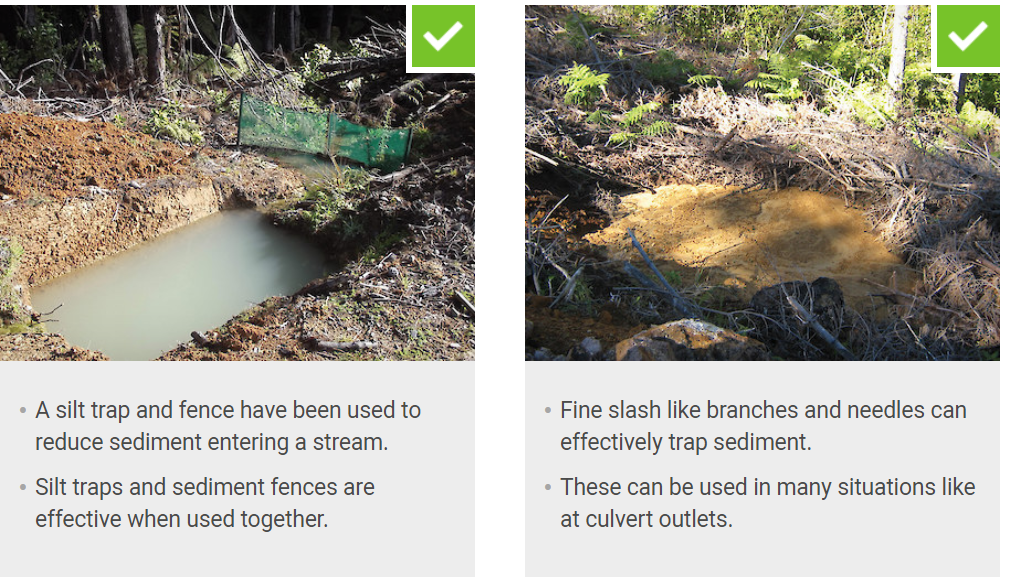
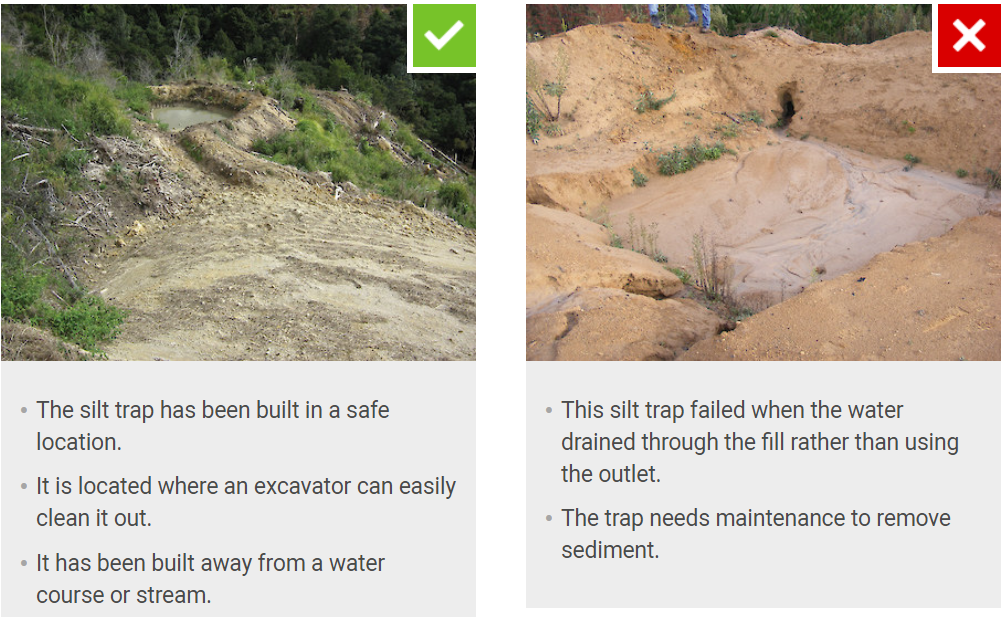
References
Basher, L. R., & Ross, C. W. (2002). Soil erosion rates under intensive vegetable production on clay loam, strongly structured soils at Pukekohe, New Zealand. Soil Research, 40(6), 947-961.
Basher, L. R., Hicks, D. M., Handyside, B., & Ross, C. W. (1997). Erosion and sediment transport from the market gardening lands at Pukekohe, Auckland, New Zealand. Journal of Hydrology (New Zealand), 73-95.
Hicks, D. L. (1995). Control of Soil Erosion on Farmland: A Summary of Erosion\‘s Impact on New Zealand Agriculture, and Farm Management Practices which Counteract it. MAF Policy, Ministry of Agriculture.